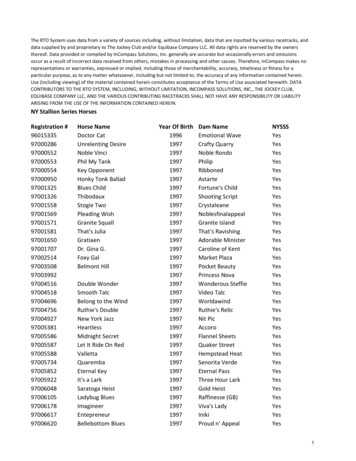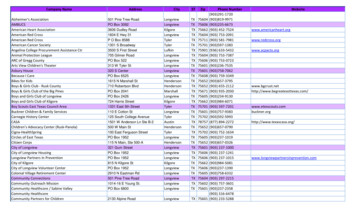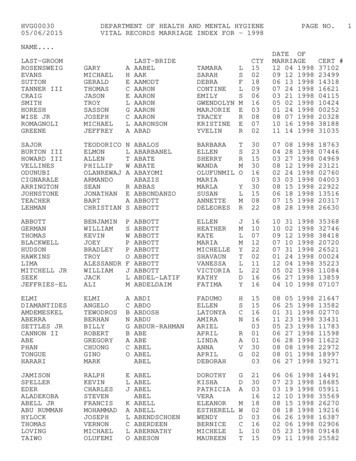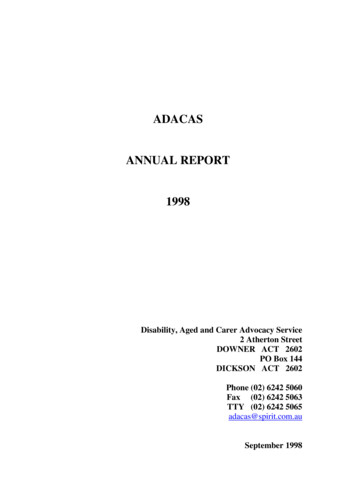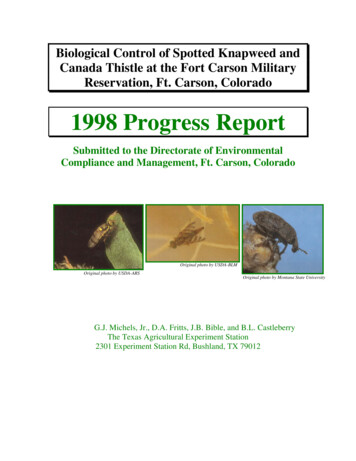
Transcription
Biological Control of Spotted Knapweed andCanada Thistle at the Fort Carson MilitaryReservation, Ft. Carson, Colorado1998 Progress ReportSubmitted to the Directorate of EnvironmentalCompliance and Management, Ft. Carson, ColoradoOriginal photo by USDA-BLMOriginal photo by USDA-ARSOriginal photo by Montana State UniversityG.J. Michels, Jr., D.A. Fritts, J.B. Bible, and B.L. CastleberryThe Texas Agricultural Experiment Station2301 Experiment Station Rd, Bushland, TX 79012
BIOLOGICAL CONTROL OF SPOTTED KNAPWEED AND CANADATHISTLE AT THE FORT CARSON MILITARY RESERVATION,FT. CARSON, COLORADO1998 PROGRESS REPORTbyG. J. Michels, Jr., D. A. Fritts, J. B. Bible, and B. L. CastleberrySubmitted to the United States Army, Directorate of Environmental Compliance andManagement, Ft. Carson, ColoradoIntroductionThe goal of the proposed biological weed control program is to reduce theexisting populations and control the spread of selected state- and federal-listed noxiousweeds at two military installations located on the Front Range of the Rocky Mountains inEastern Colorado. The two sites are: the Fort Carson Military Reservation (FCMR) atColorado Springs, CO and the Piñon Canyon Maneuver Site (PCMS) at Trinidad, CO. Inthe initial program, spotted and diffuse knapweed and Canada thistle are the targetspecies.The objectives of the research are to 1. Develop and implement procedures andsampling methods to assess the present state of any existing biological controls on theselected species at FCMR and/or PCMS; 2. Monitor abiotic and biotic factors that maybe peculiar to FCMR and/or the PCMS through field data collection and release-siteweather stations. Assess the impact of these factors on establishment of natural enemies;3. Conduct greenhouse studies to determine the interaction of several available naturalenemies of the selected weed species with each other and their combined effect on theplant, and conduct herbicide/natural enemy compatibility tests to help make decisions forIPM strategies. Use the greenhouse populations of the natural enemies for additionalreleases; 4. Release several species of natural enemies in field trials using release cagesand open field releases to compare survival and establishment over a period of at leastthree years. Monitor and redistribute established populations.This report describes the progress during 1998 and early 1999. Severalorganizations have cooperated with this project, including the Colorado Department ofAgriculture, Forestry Sciences Laboratory at Montana State University, USDA-APHIS atMontana State University, Pennsylvania Department of Agriculture, and USDA-APHISat Spokane, Washington.On the CoverUrophora affinis, the banded gall fly, was released at Cantonment I and TurkeyCreek (spotted knapweed sites) in 1997 and was recovered from both locations in 1998.2
Five hundred Chaetorellia acrolophi, the knapweed peacock fly, were released at theTurkey Creek site in July 1998. Larvae from seed heads were recovered in October 1998and adults emerged in January 1999.Larinus minutus, the lesser knapweed flower weevil, was released in 1997 at the TurkeyCreek and Cantonment I sites. It was recovered from both sites in 1998.ChronologyJanuaryThree cages containing Urophora cardui galls, obtained from Dr. George Markin,Forestry Sciences Laboratory, Montana State University, were placed at two new Canadathistle sites on January 28, 1998 (Fig.1). The galls are rated on a scale of 1 – 5 accordingto the size of the gall, with a 1 rating approximately walnut-size and a 5 ratingapproximately pea-size. It takes 80 size 1 galls to release about 1000 live larvae and 200size 4 galls for 1000 live larvae (Table 1). The two sites are designated as OutdoorRecreation and Duck Pond (Table 2). At each of the new release sites, plant height anddensity were recorded at 10, 20 and 30-m intervals where possible to obtain baselineinformation for future comparison data (Tables 3 and 4).Knapweed plants at the Cantonment I and Turkey Creek sites were examined forL. minutus emergence holes. Emergence holes were found at the Cantonment I site insidethe cage and within 10-m of the open release site.Seed heads were collected from the Cantonment I and Turkey Creek sites todetermine the number of U. quadrifasciata and U. affinis galls. At each site, both L.minutus and U. affinis had been released in June 1997. Approximately 100 seed headswere collected from each release location for a total of 400 seed heads at both sites. Fiftyseed heads were dissected from both L minutus and U. affinis release areas for a total of200 seed heads at both sites (Table 5). No galls were determined to be caused by U.affinis. However, the Urophora larvae were retained in individual containers for speciesconfirmation upon emergence. Larvae were found from the 1st and 2nd generations, butthe 1st generation larvae were dead.AprilOn April 21st, 1998, Cassida rubiginosa adults were found in field cages in whichthey had been released on musk thistle, Carduus nutans L., at Bushland, Texas in the latesummer of 1997, indicating the C. rubiginosa overwintered in Bushland during 1997-98.A new release of the spotted knapweed seed head moth, Metzneria paucipunctella(Zeller) was made on April 28, 1998. The releases were made at three sites, TurkeyCreek, Duck Pond, and a new site designated as the Bunker site. Each release consistedof approximately 3000 Metzneria-infested knapweed seed heads. Of this 3000,approximately 2160 Metzneria will emerge (72% emergence) (Table 2).3
Fig. 1. Urophora cardui galls are placed in small screened cages to prevent rodent predation. Each gall israted on a scale of 1 – 5. Galls with a 1 rating are approximately the size of a walnut and a 5 rating isapproximately pea size. It takes 80 size 1 galls to release about 1000 live larvae and 200 size 4 galls for1000 live larvae. Releases were made at two Canada thistle sites designated as Duck Pond and ARArelease sites in Fort Carson, Colorado in 1998.4
Table 1. Scale to determine the approximate number of live Urophora cardui larvae per gall. Scale derivedby Dr. George Markin, Forestry Sciences Laboratory, MSU, Bozeman, MT.live larvaeVolume(cm3) vs. live252015105003.5710.514Vol (cm3)Class12345Approx.# live larvae/gall1210854Class1234# galls / 1000 live larvae80100125200Class12345Gall volume (cm3)7.55 “walnut size”6.14.32.41.35
Table 2. Summary of Insects Released for Biological Control of Canada Thistle and Spotted Knapweed, 1997-1998.Common NameSpeciesAgency1998 releases in BOLDThistle-feeding shield beetleThistle-feeding shield beetleCanada thistle bud weevilCanada thistle bud weevilReleaseSite1DateCassida rubiginosaCassida rubiginosaLarinus planusLarinus planusCanada thistle (Cirsium arvense )Penn.Dpt.of Agric.Penn.Dpt.of Agric.Penn.Dpt.of Agric.Penn.Dpt.of erCage/Open433325 / 015 / 047 / 00/150Thistle stem gall flyUrophora carduiForestry Sci Lab,MT01/28/199860 / 77Thistle stem gall flyUrophora carduiForestry Sci Lab,MT01/28/199870 / 92Thistle stem gall flyUrophora carduiForestry Sci Lab,MT01/15/199930/1Thistle stem gall flyUrophora carduiForestry Sci Lab,MT01/15/199940/1Thistle stem gall flyUrophora carduiForestry Sci Lab,MT01/15/199960/1Thistle stem gall flyUrophora carduiForestry Sci Lab,MT01/14/199970/1Sulphur knapweed mothAgapeta zoeganaColo.Dpt.of Agric08/05/1998150 / 0Spotted knapweed (Centaurea maculosa )Knapweed peacock flyChaetorellia acrolophiColo.Dpt.of Agric07/02/19982250/250Knapweed root weevilCyphocleonus achaetesColo.Dpt.of Agric08/06/1997550/200Knapweed root weevilCyphocleonus achaetesColo.Dpt.of Agric08/04/1998550/150Lesser knapweed flower weevilLarinus minutusUSDA/APHIS, MT06/05/1997150 / 50Lesser knapweed flower weevilLarinus minutusUSDA/APHIS, MT06/05/1997250 / 50Spotted knapweed seed head mothMetzneria paucipunctellaUSDA/APHIS, WA04/28/199820/2Spotted knapweed seed head mothMetzneria paucipunctellaUSDA/APHIS, WA04/28/199870/2Spotted knapweed seed head mothMetzneria paucipunctellaUSDA/APHIS, WA04/28/1998-0/1Banded gall flyUrophora affinisUSDA/APHIS, MT06/05/199710/1Banded gall flyKnapweed seed head flyUrophora affinisUrophora quadrifasciataUSDA/APHIS, MT06/05/1997determined to be previously established20/11Sites: 1-Cantonment I; 2-Turkey Creek; 3-ARA; 4-Reservoir; 5-Cantonment II; 6-Outdoor Recreation; 7-Duck Pond2Released in bouquets of dead spotted knapweed with approximately 1200 larvae/bouquet.3Released in galls, approximately 7 larvae/gall. Releases were made in small screened boxes to prevent rodent predation.4Recovered on 7/2/98.5Released in screened boxes containing infested seedheads; 2400 seedheads/box, approx. 1728 larvae/box (72% infestation)6Released at HazMaterials Site which was accidently mowed at a later date, then abandoned.7Galls rated on a scale of 1 - 4;class 1 80 galls/1000 live larve;class 4 200 galls/1000 live larvae6
TableCanadathistlethistleplantheightat UrophoraFt. CO,Carson,CO,1998.January 1998.Table 3.3.Canadaplantheightat Urophoracarduiicarduireleasereleasesites, Ft.sites,Carson,JanuaryPlant No10mSite: Duck Avg.Avg.Avg.Avg.Avg.713233624148Plant Height (cm) at indicated meters from release point20m30m10mSite: Outdoor RecreationPoint of Release12092876980 1085272 1027981 1038077988080 20m526257506457
Table 4. Canada thistle plant density at Urophora carduii release sites, Ft. Carson, CO, January 1998.2Release Site0mSite: Duck Pond12310m822411123782820Plants/m at indicated distance from release point20m30m0m10m20m 30mSite: Outdoor RecreationPoint of 66276
Table 5. Summary of insects recovered on spotted knapweed at Ft. Carson, CO, in 1998.ReleaseCommon nameSpeciesSource1SiteNumberTotalDateCaged OpenLesser knapweed flower weevil Larinus minutusHelena, MT06/05/19971 30-50 50-70100Lesser knapweed flower weevil Larinus minutusHelena, MT06/05/19972 30-50 50-70100Banded gall flyBanded gall flyUrophora affinisUrophora affinisThree Forks, MTThree Forks, MT06/05/199706/05/19971211Knapweed peacock flyChaetorellia acrolophiPalisade, CO07/02/199822501Sites: 1- Cantonment I; 2- Turkey CreekData obtained from the seedhead samples collected in September and October 1998 only.3Released in bouquets of dead spotted knapweed with approximately 1200 010/28/19982250253 480033 4800250Recovered2Site #/50 heads TotalCaged Open07/02/19981551007/02/19982066Date
JuneAll release sites (Canada thistle and Spotted knapweed) were georeferenced onJune 2nd and June 3rd, 1998. Maps were generated by Linda Moeder, DECAM (Fig.2).The Bunker site, which was a new release site, had inadvertently been mowed; thereforegeoreferencing was not necessary. This area will be monitored, but no future releases areplanned for this site. Seedheads from all sites were collected and brought back toBushland, Texas for further examination. On June 12th, 1998, U. affinis emerged fromseed heads collected from both open field collections and cage collections at the TurkeyCreek site. U. affinis also emerged from open field collections from the Cantonment Isite (Table 5).JulyOn July 2nd, 1998, an 8’ X 6’ cage provided by Mr. Fred Stahl, ColoradoDepartment of Agriculture, was erected at the Turkey Creek release site. Chaetorelliaacrolophi, the knapweed peacock fly, was released in the cage and in the open (Table 2).Both Larinus minutus and Urophora affinis were recovered (Table 5). We collectedseveral unknown insects at the Duck Pond site and sent them to the SystematicEntomology Laboratory in Beltsville, MD for positive identification. Results arepending. Spotted knapweed plants were collected and brought back to Bushland forgreenhouse colony rearing and future studies. Mr. Jim Stimmel, PennsylvaniaDepartment of Agriculture, Harrisburg, PA provided Larinus planus and Cassidarubiginosa, for release on Canada thistle. Both releases were made at the ARA site onJuly 8, 1998 (Table 2).AugustOn August 4th, 1998, Cyphocleonus achates adults were released in the cage andin the open at the Cantonment II site (Table 2). No recoveries of previously released C.achates were made. At Cantonment I the first cage release of Agapeta zoegana, thesulphur knapweed moth (also called the yellow-winged knapweed root moth), was madeon August 5th, 1998 (Table 2).OctoberAn older cage was replaced at the Cantonment II site on Oct. 1st, 1998 (Fig. 3).Seed heads were collected from all sites except Turkey Creek, which was inaccessibledue to training maneuvers in the area. No recoveries were made. On October 29th, 1998,we met with Ms. Linda Moeder, DECAM, for training on Arcview and GIS/GPScomputer technology.DecemberFifty seedheads were dissected from each release site and larvae recovered fromthe spotted knapweed seed heads were recorded (Tables 6 & 7). The Chaetorelliaacrolophi larvae were recovered from the caged site at Turkey Creek (Table 5). Theyemerged in January 1999. Urophora affinis larvae were also recovered from opencollections made at Turkey Creek and Cantonment II. A tephridid fly species (Terelliaruficauda) was recovered from all three Canada thistle sites and is pending positive10
Canada Thistle SitesARADuck PondOutdoor RecreationReservoirSpotted Knapweed SitesTurkey CreekCantonment ICantonment IIFig. 1. Georeferenced release sites located at Fort Carson, Colorado, in April, 1998.ARA, Outdoor Recreation, Reservoir, and Duck Pond are the sites infested with Canadathistle. Turkey Creek, Cantonment I, and Cantonment II are Spotted knapweed sites.11
Fig. 3. A new cage was erected at the Cantonment II release site at Fort Carson, Colorado in 1998. It ismade of a lighter, less dense material that allows better sunlight penetration as well as less water retention,but retains the strength and protection of the other cages used.12
Table 6. Summary of U. quadrifasciata larvae recovered from spotted knapweed in 1998.Status1Larval densitytotal/50average/seedheads seedheadstd.errorEmerging adultstotalpercentLarval frequency distribution2012 3 4 5 6 7 8 9 101268 6 8 6 2 1 0 1019 107 5 4 1 2 2 0 003384 3 0 2 0 0 0 0020 145 5 4 1 1 0 0 00175 5 2 7 3 3 1 00Cantonment I 8Cantonment I CageLiveDeadTotal7798671.00Turkey Creek CageLiveDeadTotal5303551.00Turkey Creek OpenLiveDeadTotal204666201.00Cantonment II CageLiveDeadTotal511712251.007Cantonment II OpenLiveDeadTotal411111541.0011 15 13 5 1 4 3 1 0 0 11Fifty seedheads were dissected from each sample. Number of larvae in galls.2Seedheads containing the specified number of larvae in a fifty seedhead sample.13
Table 7. Summary of three different larvae species recovered from spotted knapweed in 1998.Status1Larval densitytotal/50average/seedheads seedheadstd.errorEmerging adultstotal percentLarval frequency distribution2012 3 4 5 6 78 9 104820 0 0 0 0 00 0 04631 0 0 0 0 00 0 04053 0 0 2 0 00 0 03828 1 1 0 0 00 0 04460 0 0 0 0 00 0 04550 0 0 0 0 00 0 04550 0 0 0 0 00 0 0U. affinisCantonment I 100.040.030.260.160.420.120.1000.00Turkey Creek CageLiveDeadTotal32520.67Turkey Creek OpenLiveDeadTotal1382160.46C. acrolophiTurkey Creek CageLiveDeadTotal421250.080.420.500.060.1330.75L. minutusTurkey Creek 100.040.020.100.000.100.100.0061.00Cantonment I OpenLiveDeadTotal41541.00Cantonment I CageLiveDeadTotal50551.001Fifty seedheads were dissected from each sample. Number of larvae in galls.2Seedheads containing the specified number of larvae in a fifty seedhead sample.14
identification. Climatic data from two weather stations located at Duck Pond and ARArelease sites was downloaded on a regular basis (Fig. 4).ResultsU. quadrifasciata data taken in 1997 was compared with the data collected in1998 (Table 8). A t-test was performed between years and also between release sites,Cantonment I and Turkey Creek (Table 9). The results indicated that there weresignificantly fewer live U. quadrifasciata larvae in 1998 than in 1997. There weresignificantly more dead larvae in 1998 than in 1997 and total larvae in 1998 weresignificantly higher than in 1997. In comparing Cantonment I and Turkey Creek releasesites within a given year, there were significantly less live and total larvae at CantonmentI than Turkey Creek in 1997. In 1998, there were significantly more dead and total larvaeat Cantonment I than Turkey Creek. One reason for the decline in U. quadrifasciatanumbers could be the establishment of one or a combination of U. affinis, L. minutus, andC. acrolophi, which also attack the seed head, and therefore, may be competing with U.quadrifasciata.Plans for 1999Field research in 1999 will continue at Fort Carson. Plant height and density datawill be recorded at all sites established in 1997 and 1998. Additional releases of C.achaetes, A. zoegana, and M.paucipunctella on spotted knapweed, and C. rubiginosa, L.planus, and U. cardui on Canada thistle will be made in 1999. In addition to theseadditive releases, new insects scheduled to be released in 1999 include: the thistle crownweevil, Trichosirocalus horridus (Panzer) and the Canada thistle stem weevil,Ceutorhynchus litura (F.) on Canada thistle; and the blunt knapweed flower weevil, L.obtusus Gyll., on spotted knapweed. Redistribution of the established insects, L. minutus,C. acrolophi, and U. affinis, will be made in 1999 on spotted knapweed. Releases ofbroad-nosed seed head weevil, Bangasternus fausti (Reitter), brown-winged root mothPelochrista medullana Staudinger, grey-winged root moth, Pterolonche inspersaStaudinger, bronze knapweed root-borer, Sphenoptera jugoslavica (Obenb.), and greenclearwingfly, Terellia virens (Loew) will be made on spotted knapweed depending onavailability of insects. Indications of insect damage to Canada thistle and spottedknapweed will be recorded. Plants will be examined for determination of insectestablishment and spread. GPS mapping will continue to be used to monitor weedinfestations at the release sites and to determine possible spread of established or newlycolonized biocontrol agents.ConclusionThis year has been a very successful year for the biological control of weedsprogram. Of the releases made to date, three species; Chaetorellia acrolophi, Larinusminutus, and Urophora affinis, are established. We will begin redistributing these newlyestablished agents to other knapweed-infested areas. We will also begin releasing abiological control agent, Aceria malherbae, and eriophyid mite on field bindweed,15
Fig. 4. Weather station located at the ARA release site at Fort Carson, Colorado. Another weather stationis located at the Duck Pond release site. These stations collect continual climatic data. The data isdownloaded onto a portable computer at regular intervals and kept for future reference and analysis.16
Table 8. Mean difference in U. quadrifasciata larvae between 2 different release sites in Ft. Carson, Coin 1997 and allivedeadtotalSamplesize (n)100100100100100100Meancantonment 51.15Std error0.200.110.220.000.260.26t- valueProb T 001t-valueProb T 10.01620.0007Table 9. Mean difference in U. quadrifasciata larvae between 1997 and 1998 for 2 differentrelease sites in Ft. Carson, CO.SiteCantonment ITurkey CreekLarvaelivedeadtotallivedeadtotalSamplesize e-0.471.581.11-1.070.39-0.68Std error0.170.230.280.140.160.19Convolvulus arvensis, which has been cleared for release through the ColoradoDepartment of Agriculture.We would like to begin a program for control of saltcedar, Tamarisk sp., with aleaf-feeding beetle, Diorhabda elongata in Piñon Canyon, pending the approval forrelease by the necessary authorities. If approval is received, we will begin a biologicalcontrol program on saltcedar in 1999.17
Common Name Species Agency 1998 releases in BOLD Date Site1 Number Cage/Open Thistle-feeding shield beetle Cassida rubiginosa Penn.Dpt.of Agric. 07/03/1997 4 25 / 0 Thistle-feeding shield beetle Cassida rubiginosa Penn.Dpt.of Agric. 07/08/1998 3 15 / 0 Canada thistle bud weevil Larinus planus Penn.Dpt.of Agric. 07/03/1997 3 47 / 0 Canada thistle bud weevil Larinus planus Penn.Dpt.of Agric. 07 .
